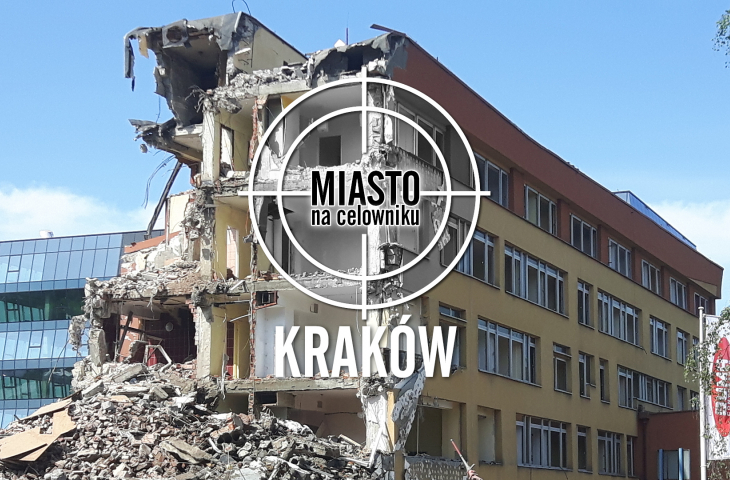During the communistera, it became a career to say that in the future it would be necessary to go through the settlements with dynamite and blow up the serial block housing built there with low aesthetic qualities: barracks-like, several-story blocks from the 1960s with blind kitchens or those erected in the next decade from large slabs, usually ten-story high.
By the way, this solution was largely applied in the West, where cheap prefabricated construction had already been phased out, and the suburban developments, populated by a low-income population, often of immigrant origin and poorly integrated with the rest of society, became a breeding ground for crime, generating political unrest.
victims of demolitions
In Poland, due to insufficient housing stock, the vision of demolishing large-panel blocks of flats is still unfulfilled. Instead, the victims of demolition are office buildings from the communistera, which, as individual investments, allowed their creators to demonstrate individual design ingenuity, and at the same time materially documented the memory of the architectural culture of the times in which they were erected.
A particular "systematization" (a term from the time of Nicolae Ceauşescu in reference to the reconstruction of Bucharest and Transylvanian villages) seems to have been subjected in Cracow to Wadowicka Street, which is a section of the road axis laid out back in the 18th century by Austrian military engineers at the founding of the town of Podgórze.
Hydropol
Two years ago, the Hydropol headquarters at No. 3 disappeared from Wadowicka Street, which was a modernist development with a functionally simplified body, typical of the late 1950s and early 1960s. The first floor and the fourth floor were indented in relation to the main body of the building, while the whole was covered by a plunging ceiling, thus slightly lowering inward. The oblique projection of the side walls beyond the face of the preceding floors gave the whole structure a lightness, while the asymmetrical arrangement of windows of different lengths prevented the impression of monotony, as did the use of colored plaster for this purpose. In turn, the entrance, protruding in front of the building's pediment and open on all sides with a mezzanine supported by pillars, was eminently decorative.
Hydropol headquarters during demolition, new investment in the background
photo: Leslaw Czaplinski
Elbud
A slightly older Elbud office building at No. 12 at Wadowicka Street is currently being demolished, representing the Socialist-Realist style, albeit with a remarkably resolved facade, with the main body rounded on the sides passing into risalits on both sides. The last storey of the pediment itself is topped with a raised roof, which is also a decorative element in the form of rectangular blendes, symmetrical with respect to the row of windows below. Those on the lower floors, in turn, are provided with surrounding, geometrized cornices, the only manifestation of ornamentation. A balcony was located above the entrance. The whole building is governed by the principle of symmetry, inherent in the classicist Socialist Realist style.
Elbud office building during demolition
photo: Lesław Czapliński
Printing Plant, Aggregate and Power Generation Plant
However, the previously rebuilt building of the former Władysław Ludwik Anczyc Printing House at 8 Wadowicka Street has survived, although apart from a risalit extending beyond the frontage, supported by two V-shaped pillars, the rest of the building has lost its original shape.
What also remains are two undistinguished office buildings: Kruszywo at No. 5 and Zaklady Remontowe Energetyki at No. 14 - an example of German pavilion architecture, widespread in the former socialist countries.
Kruszywo office building at 5 Wadowicka Street
photo: Lesław Czaplińsk
erased memory
Thus, not only is the memory of the past erased, but also the continuity of the urban fabric of the city. The place of architectural diversity is being replaced by a stylistic monotony of banal buildings, as heralded by both the terraced buildings being erected on the site of Hydropol, duplicating the same pattern three times, and the visualizations of those that will replace Elbud.
burzymurkowie
In the 19th century, the infamous name of "burzymurks" was earned by those responsible for the disappearance of the City Hall, the city fortifications and the churches of St. Stephen and All Saints from the topography of Krakow. In 1892, as a gesture of protest, Jan Matejko returned his honorary citizenship of the city of Cracow in connection with the demolition of the buildings of Poduchaty (church, monastery and hospital) in order to obtain land for the construction of a new Municipal Theater.
Will there be his successor in the city's public life today, who will try to oppose such reckless decisions? The removal of architectural structures from space is not only the acquisition of valuable plots of land for commercial purposes, but also a kind of historical policy that removes from the collective consciousness the memory of politically undesirable periods in the past.






























